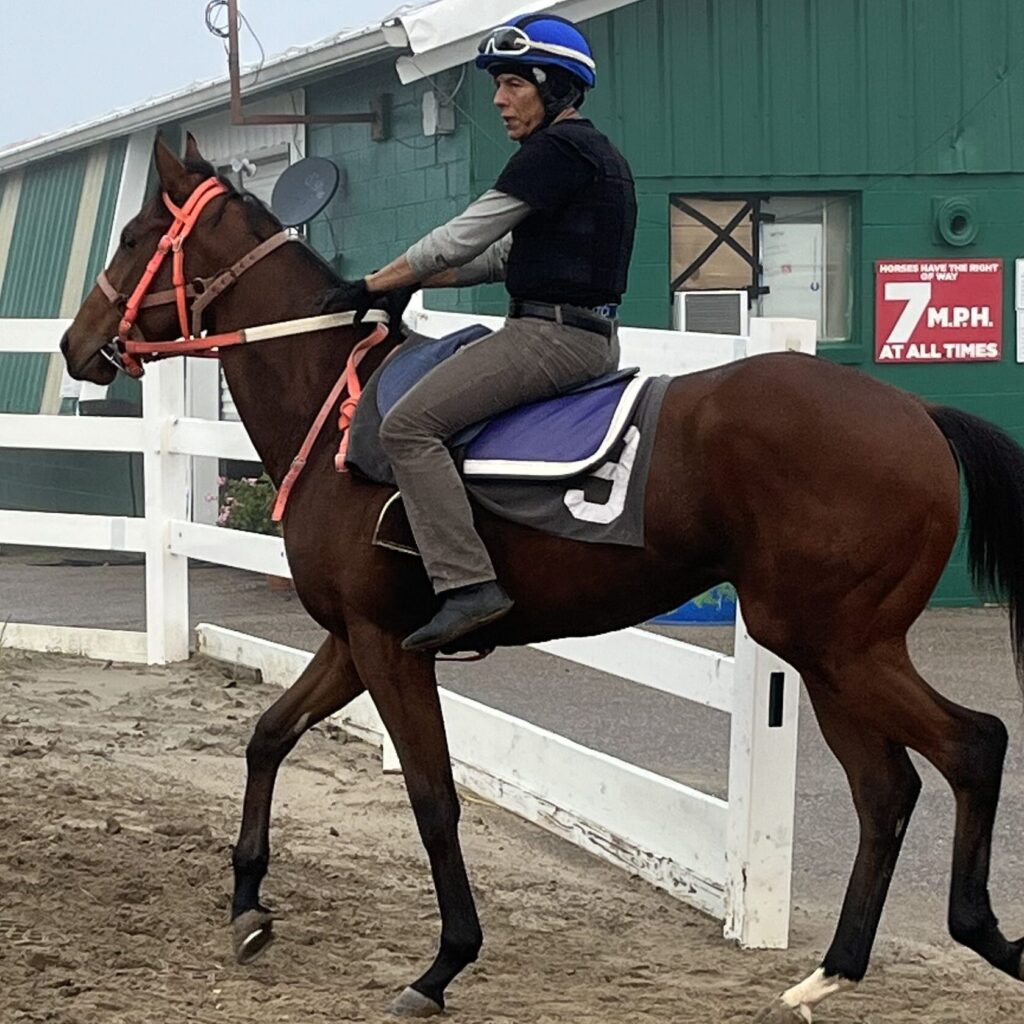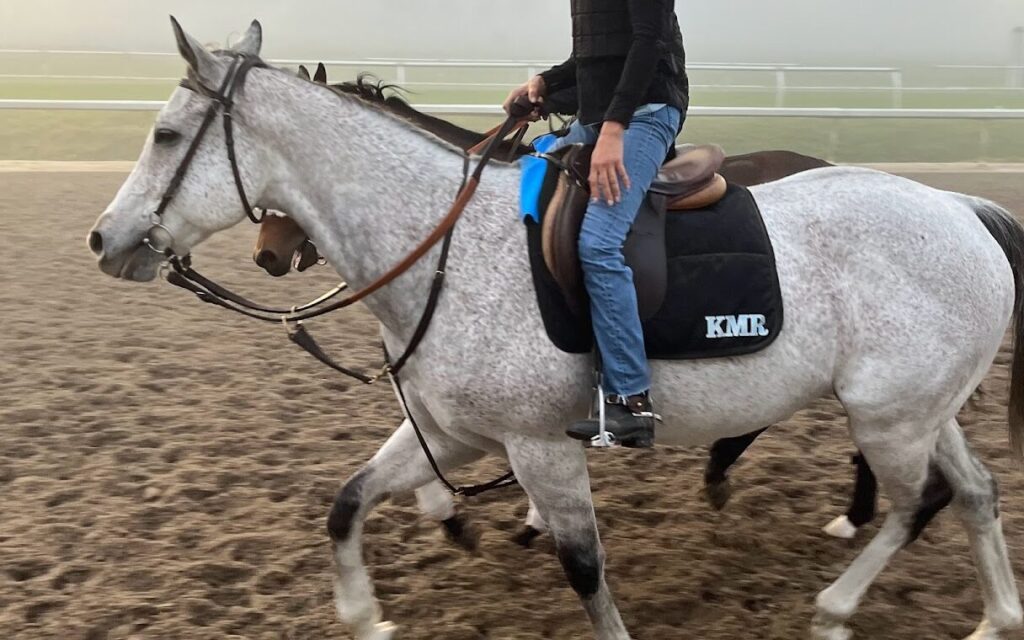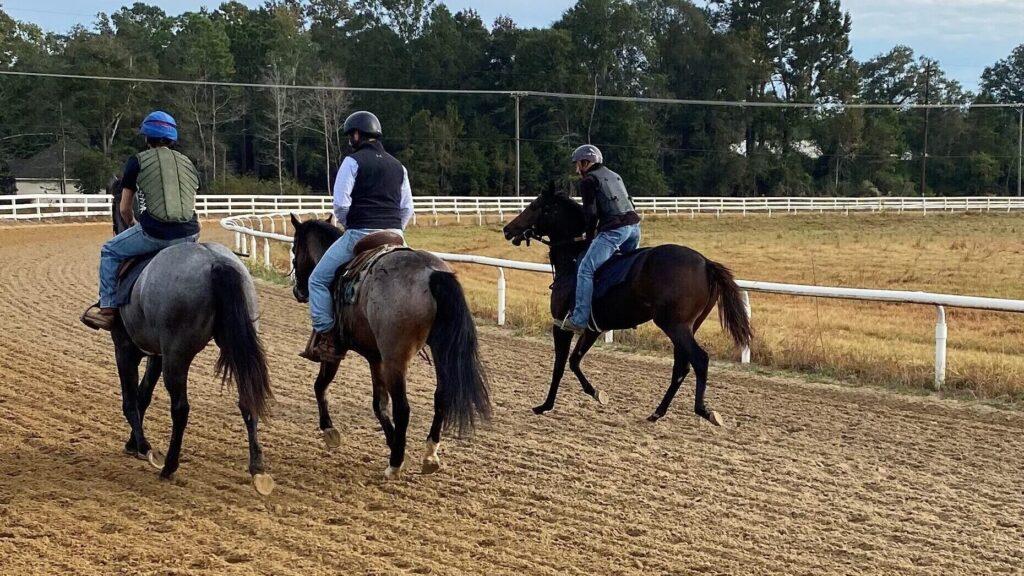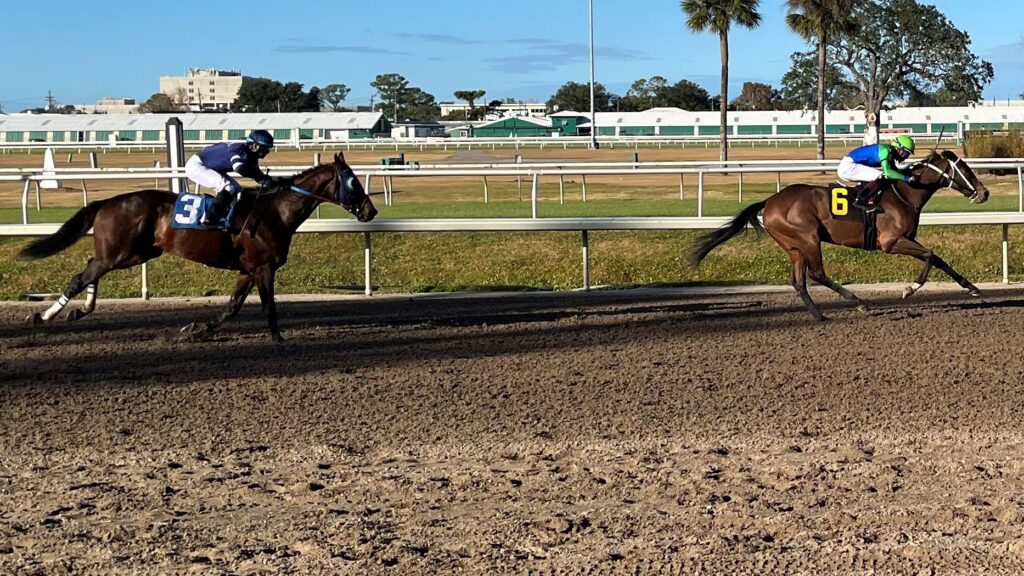Last updated: January 19, 2023
As a horse racing enthusiast, I’ve always been fascinated by the intense training and preparation that goes into getting a racehorse ready for competition. One aspect of this process that has always intrigued me is the concept of horse racing workouts.
For those unfamiliar with the term, horse racing workouts involve a horse being exercised on a track or other surface, often with the goal of improving its fitness and performance. Workouts can take many forms and provide valuable insights into a horse’s physical condition and progress.
People often wonder about how workouts are conducted and how they can be used for betting decisions. That’s why I decided to do some research and compile this beginner’s guide to understanding horse racing workouts.
In this article, I dive into the various types of workouts, the terminology used in workout reports, and the role that workouts play in horse racing. By the end, you’ll have a solid foundation for interpreting and using horse racing workouts to your advantage.
Basics of Horse Racing Workouts
Horse racing workouts are an important part of training and preparing racehorses for competition. They provide trainers with a way to evaluate a horse’s physical condition and progress and can be a valuable tool for bettors looking to gain an edge.

There are several types of workouts, including breezes, gallops, and official works. Breezes are workouts in which a horse is asked to run at a moderate pace, typically covering a distance of 3 to 5 eighths of a mile.
The purpose of a breeze is to build a horse’s endurance and improve its overall fitness. Gallops are workouts in which a horse is asked to run more relaxed, typically covering a distance of 1 mile or more. The purpose of a gallop is to help a horse maintain its fitness and build endurance.
Official works are workouts in which a horse is run a specific distance to show its speed or get cleared for racing. Official works are used to evaluate a horse’s speed and condition and can be used to help trainers set specific goals for a horse’s training.
By understanding the different types of horse racing workouts and how they are used, you can get a better sense of how trainers prepare their horses for competition and how a horse’s performance during a workout may indicate its potential as a competitor.
In addition to these types of workouts, trainers may also use other training methods such as swimming, hill work, or sand running to prepare their horses for competition.
When it comes to reporting on horse racing workouts, several key pieces of information are typically included. These may include:
- The distance of the workout
- The surface on which the workout was conducted
- The time it took the horse to complete the workout (in seconds or fractions of a second)
- The horse’s position during this day, for example, 1/15, indicates the fastest time of 15 horses.
- Any comments from the clocker about the horse’s performance, breezing, from the gate, etc.
By understanding these basic elements of horse racing workouts, you can gain insight into how a horse is progressing in its training and what its potential may be as a competitor.
Are official works required?
Most horses are not required to have an official work before it races. However, some racing jurisdictions may have specific rules or regulations that require horses to have an official work within a certain time frame before a race.
For example, if it’s the first time a horse has started a race, or if the horse has had a long layoff from racing, they are required to have an official work within a certain number of days before a race in order to be eligible to compete.
In addition, if your horse finishes a race poorly, an official workout may be required. We once had a horse break bad, and the jockey pulled him up and jogged to the finish line. Before our horse was allowed to enter another race, he had to perform an official work within a specified time.
It’s important to note that while official works are not typically required before racing, they can still be a valuable tool for trainers as they prepare horses for competition.
By conducting official works and analyzing the results, trainers can get a sense of a horse’s physical condition, ability, and potential as a competitor. They can use that information to adjust their training and preparation.
The specific rules and regulations regarding official works may vary depending on the racing jurisdiction and the race in question. It’s always important to be aware of all requirements that may apply to a particular race.

In most cases, the official time for a horse’s work is recorded by a clocker. Clockers are individuals who are responsible for timing horses during their workouts and recording the results. They work for racing associations and sit in a booth near the track.
To record the official time for a horse’s work, a clocker will typically use a stopwatch or other timing device to measure the horse’s speed and distance.
In addition to timing horses during workouts, clockers are also responsible for recording other information about the workout, such as the surface on which the horse ran, the weather conditions, and any comments or observations made by the trainer or exercise rider.
On a typical day when we bring our horses for an official work, we ask the jockey who normally rides them during races to join us. Before the work begins, we give the jockey instructions on the pace we want the horse to maintain during the workout.
We then approach the official clocker and provide them with the name of our horse and the distance it will be working. After our last official work, the clocker provided the following information:
| Track | Date | Course | Distance | Time | Note | Rank |
|---|---|---|---|---|---|---|
| Fairgrounds | 12/3/2022 | Dirt | 3F | 38.60 | Breezing | 3/5 |
Common terminology used in workout reports.
There are a number of terms and measurements that are commonly used in horse racing workout reports to describe a horse’s performance. Some of the most important ones to understand include the following:
- Distances: Workouts are typically measured in distances, such as furlongs (1/8 of a mile) or miles. The distance of a workout can give you an idea of the horse’s endurance and how it is progressing in its training.
- Course: The surface on which a workout is conducted can significantly impact a horse’s performance. Different surfaces (e.g. dirt, turf, synthetic) can affect a horse’s footing and its ability to run at different speeds.
- From the gate: Most works are timed from a running start; however, when a horse starts from the starting gates, this is included in the notes.
- Breezing: This means the horse wasn’t pushed hard by the jockey.
- Easy: This is another term lockers use to indicate the horse wasn’t asked to run hard.
By understanding these terms and measurements, you can better interpret workout reports and get a sense of how a horse performs during its training.
Here’s a YouTube video of our two-year-olds working together.
Factors that can influence a horse’s workout performance (e.g., weather, track conditions, trainer goals)
There are several factors that can influence a horse’s performance during a workout. The weather can have a significant impact, as extreme heat or cold can affect a horse’s energy levels and ability to perform at its best.
A wet or muddy track may be more difficult for a horse to navigate, while a dry or hard track may allow for faster times. The trainer’s goals can also affect a horse’s performance during a workout.
For example, my trainer never asked a jockey to push a horse during workouts. However, some trainers may focus on improving a horse’s speed and conduct faster workouts to achieve this goal.
On the other hand, a trainer may be more focused on building a horse’s endurance and may conduct longer, slower workouts to achieve this. The horse’s physical condition can also influence its performance during a workout.
Factors such as age, fitness level, and overall health can all impact a horse’s ability to perform at its best. Also, when you work horses with company they typically go faster than they do alone.
By considering these and other factors, you can better understand how a horse’s performance during a workout may be influenced and what it may mean for its future performances.
Here is a chart that depicts common official workout distances and times for timed workouts:
| Distance | Time |
|---|---|
| 3/8 mile | :38 |
| 1/2 mile | :49 |
| 5/8 mile | 1:00 |
| 3/4 mile | 1:13 |
It’s important to note that these times are just estimates and may vary depending on the specific horse and the conditions under which the workout is conducted. Additionally, these are just a few examples of common official workout distances and times, and trainers may also use other distances and times.
Below is a helpful YouTube video that shows a trainer exercising a racehorse.
Analyzing Horse Racing Workouts
Analyzing horse racing workouts can be useful for trainers, owners, and bettors. By understanding how to interpret workout reports and considering multiple workouts in context, you can gain valuable insights into a horse’s physical condition and potential as a competitor.
Here are some tips for analyzing horse racing workouts:
- Pay attention to the distance and surface of the workout. These factors can give you an idea of the horse’s endurance and how it is progressing in its training.
- Look at the fractions and final speed of the workout. Faster fractions and higher speeds can indicate that a horse is in good form and may be ready to compete at a higher level.
- Consider the horse’s previous performances and workouts. Comparing a horse’s current workouts to its previous ones can help you understand how it is progressing and whether it is improving or regressing.
- Take note of any comments from the clocker. These can provide valuable insights into the conditions of the workout.
- Don’t rely on a single workout to make a decision. It’s important to consider multiple workouts and to analyze them in the context of the horse’s overall training and condition.
By following these tips, you can begin to build a more comprehensive understanding of a horse’s potential and use that information to inform your betting decisions.

Using Horse Racing Workouts in Betting Strategies
Using horse racing workouts in betting strategies can be a valuable tool for gaining an edge in your wagers. To get the most out of workout analysis, it’s important to consider multiple factors such as the distance and surface of the workout, the fractions and final time, and the horse’s class level.
Paying attention to these factors can help you better understand a horse’s physical condition and potential as a competitor. However, it’s important to remember that no single factor can guarantee a win, and it’s always important to consider various factors when making betting decisions.
To get the most out of workout analysis, it’s also important to consider multiple workouts and to analyze them in the context of the horse’s overall training and condition. Using these tips, you can begin incorporating workout analysis into your betting strategies and potentially increase your chances of success.
There are a number of betting strategies that can be successful when incorporating workout analysis. Here are a few examples:
- Betting on horses based on their fractions. For example, if a horse is entered in long races you want to see faster fractions at the later distances.
- Focusing on horses that show improvement in their workouts: By looking for horses that are consistently improving in their workouts, you may be able to identify horses that are peaking at the right time and may be ready to perform at their best in a race.
- Betting on horses with a strong record on the surface of the race: By analyzing workouts and considering a horse’s performance on different surfaces, you can potentially identify horses that may be more suited to certain types of surfaces and be more competitive in a race.
- Paying attention to the clocker comments: Comments from the clocker can provide valuable insights into the track condition and horse’s exertion during workouts.
It’s important to remember that no single betting strategy is guaranteed to be successful, and it’s always important to consider all factors when making betting decisions. However, by incorporating workout analysis into your betting strategies, you may be able to increase your chances of success.
What are fractions
In horse racing, fractions refer to the time it takes a horse to cover specific distances during a race or workout. Fractions are often used to describe a horse’s performance in a race and can provide valuable insights into a horse’s speed and strength.
For example, if a horse runs a race in 1:45 and is clocked at :25 for the first quarter mile, :50 for the half mile, and 1:15 for three-quarters of a mile, the fractions for the race would be :25, :50, and 1:15.
These fractions can provide valuable information about a horse’s pace and performance during the race and can be used to help identify strengths and weaknesses in a horse’s racing style.
Overall, fractions can be a valuable tool for understanding a horse’s performance and can provide valuable insights into a horse’s speed and endurance.

Summary
Workouts in horse racing refer to training exercises done with the horse in preparation for a race. These exercises can include galloping at various speeds, running timed intervals, and working on specific skills, such as starting from the starting gate.
Workouts are typically done on a training track or other training facility and are usually overseen by the horse’s trainer. The purpose of workouts is to prepare the horse for the physical demands of racing, to improve its performance, and to evaluate its progress.
The schedule and type of workout will vary depending on the horse’s fitness level, the race it prepares for, and the trainer’s specific training plan. Some of the common types of workouts used in horse racing include:
- Galloping is the most basic type of workout, where the horse runs steadily for a certain distance.
- Breezing: This is a type of workout where the horse runs at a faster pace than galloping but is still under control.
- Gate Workouts: This type of workout is designed to prepare the horse for starting from the starting gate, which is a critical aspect of a race.
Horse racing workouts are crucial to training and preparing racehorses for competition. Understanding and analyzing workouts can provide valuable insights into a horse’s physical condition and potential as a competitor.
Additionally, by using workout analysis as part of your betting strategies, you may be able to increase your chances of success. While no single factor can guarantee a win, by considering multiple factors and analyzing workouts in the context of a horse’s overall performance, you can gain a more comprehensive understanding of a horse’s potential and use that information to help make your betting choices.
FAQs
What is a good 4 furlong workout time?
A good 4-furlong (half-mile) workout time for a Thoroughbred racehorse is around 48 seconds. However, this will depend on the condition of the track. A slower time may be acceptable for a lower-level horse or on a deep or muddy track.
What is a good 3 furlong workout time?
A good 3 furlong workout time for a Thoroughbred racehorse is around 37 seconds. However, this will vary based on the track condition. Also, faster times can be expected from high-end racehorses.
Additional Resources

About the Author: Miles Henry
Lifelong Horseman | Racehorse Owner | Published Author
Miles Henry brings over 25 years of hands-on experience training and owning Thoroughbred racehorses. Raised with Quarter Horses and Appaloosas, he’s spent a lifetime learning from horses—on the track, in the barn, and in the field. Today, he runs a small but successful racing stable in Louisiana and shares real-world insights on HorseRacingSense.com, helping horse owners, fans, and bettors navigate the sport with confidence.
📚 Books: View Miles’s books on Amazon »
🎧 Podcast Guest: Animal Tales Ep. 32 |
YouTube Interview
📩 Newsletter: Sign up for racing tips and horse care advice »
🔗 Follow Miles:
Twitter |
Facebook |
YouTube



